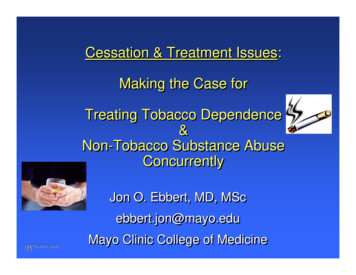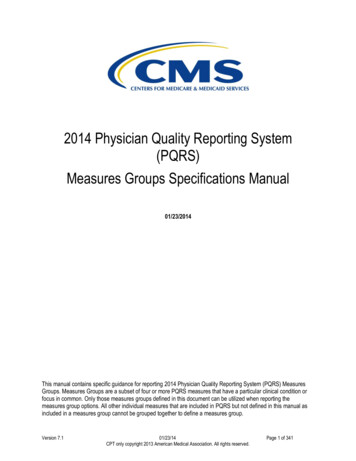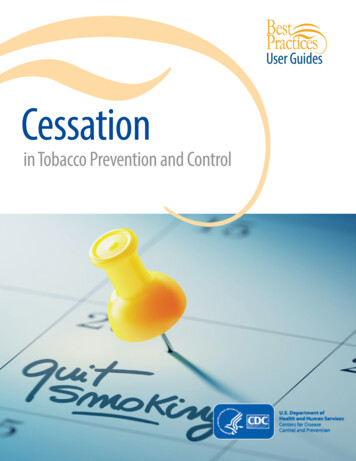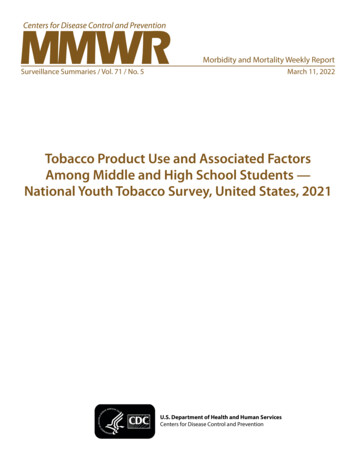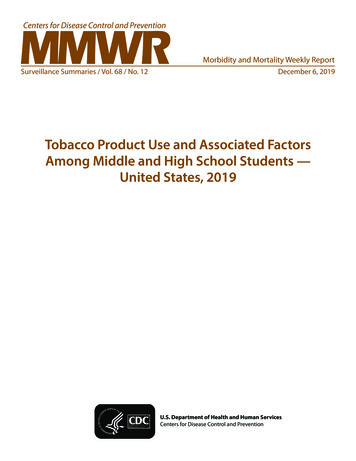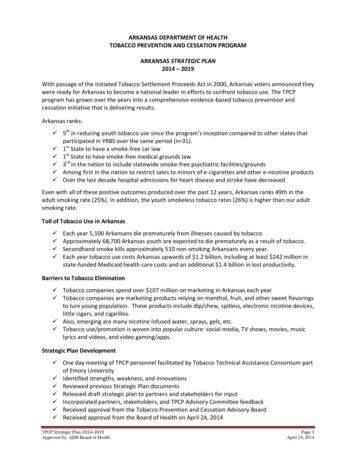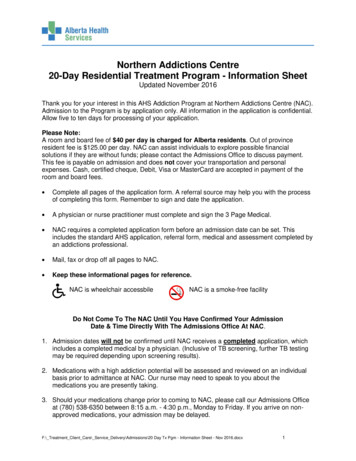
Transcription
Addressing Tobacco Treatment inMental and Behavioral Health SettingsCHIZIMUZO (ZIM) T.C. OKOLI, PHD, MPH, MSN, RN, NCTTPASSOCIATE PROFESSOR, UNIVERSITY OF KENTUCKY COLLEGE OF NURSINGEXECUTIVE DIRECTOR OF MENTAL AND BEHAVIORAL HEALTH, BH WELLCO-DIRECTOR OF TOBACCO TREATMENT AND PREVENTION, BREATHEDIRECTOR OF BEHAVIORAL HEALTH EVIDENCE BASED PRACTICE AND RESEARCH, EASTERN STATE HOSPITALNURSE SCIENTIST-BEHAVIORAL HEALTH, UKHEALTHCARE
Goals of this presentation Describe tobacco use among persons living with mentaland behavioral health challenges Explain best practices in addressing tobacco treatment inbehavioral health settings Discuss toolkits and resources to enhance engagingbehavioral health organizations in adopting tobacco freepolicies and treatment
Why Engage Persons with mentaland behavioral health challenges inTobacco Treatment?https://pixabay.com/
Little decline in smoking prevalenceamong those with mental illnessesUS Department of Health and Human Services. (2014). The health consequences of smoking—50 years of progress: a report of the Surgeon General. Atlanta,GAData from the National Health Interview Survey. Current smoking is defined as those who had smoked 100 cigarettes in their lifetime and smoked daily or somedays at time of the interview. This illustration was obtained with permission from the SAMHSA CBHSQ Report, July les/spot120-smokingspd /spot120-smokingSPD.pdf
Prevalence of Smoking by MI/SUD DisorderKalman, Morissette, & George. “Co-Morbidity of Smoking in Patientswith Psychiatric and Substance Use Disorders.” The American journalon addictions / American Academy of Psychiatrists in Alcoholism andAddictions 14.2 (2005): 106–123. PMC. Web. 7 Mar. 2016
Effects of smoking among persons with MI/SUDSmokers with MI/SUD: Die 10-25 years earlier Have more depression and anxiety Have more substance use problems Have more cardiovascular andcardiopulmonary problems Are more likely to commit suicide Have sexual problemsNonsmokers with MI/SUD: Have better health Live longer Need less medication Have less depression Save more moneyParks, Svendsen, Singer, Foti (2006). Morbidity and Mortality in People with Serious Mental Illness.National Association of State Mental Health Program Directors (NASMHPD). Medical Directors Council www.masmhpd.org
Smoking is the leading cause of death in individualswith mental illness and substance use disorders!Hurt, R. D., Offord, K. P., Croghan, I. T., Gomez-Dahl, L., Kottke, T. E., Morse, R. M., & Melton, L. J. (1996). Mortality following inpatient addictions treatment: Role of tobacco use in acommunity-based cohort. Jama, 275(14), 1097-1103.
Why do people withMI/SUD use tobacco?https://pixabay.com/
Reasons for smoking among persons with MIGenetic Smoking and major depression 1,2 Nicotine dependence and PTSD 3 Smoking behaviors and schizophrenia 4Bio-behavioral Nicotine reduces sensorimotor gating inschizophrenia 5 Smoking reduces brain levels of MAO-A(an enzyme linked to depression) 6 Nicotine may be an anxiolytic 7 Smoking used as a ‘token economy’ inmental health facilities 8 Smoking encouraged as a means ofenhancing ‘socialization’ among patients9Psychosocial1. Kendler, et al. Smoking and Major Depression: A Causal Analysis. Archives of General Psychiatry 1993; 50:36-432. Lyons, et al. A twin study of smoking, nicotine dependence, and major depression in men. Nicotine & Tobacco Research 2008; 10:97 – 1083. Koenen, et al. A Twin Registry Study of the Relationship Between Posttraumatic Stress Disorder and Nicotine Dependence in Men. Arch Gen Psych 2005; 62:1258-12654. Faraone, et al. (2004). A novel permutation testing method implicates sixteen nicotinic acetylcholine receptor genes as risk factors for smoking in Schizophrenia families5. Postma, et al. (2006). Psychopharmacology, 184: 589–5996. Fowler, et al. (1996). Proceedings of the National Academy of Sciences of the United States of America, 93:14065-140697. McCabe, et al. (2004). Journal of Anxiety Disorders, 18:7-188. Lawn S. Cigarette smoking in psychiatric settings: occupational health, safety, welfare and legal concerns. Australian and New Zealand J Psych 2005; 39:886-8919. Kawachi I, Berkman L. Social ties and mental health. Journal of Urban Health 2001; 78:458-467
Reasons to treat tobacco use in persons with MISiru et al.,TheyWANT to 2009Stockingsquit!et al., 2013TheyAREABLE toquit!Psychiatricsymptoms 50% contemplating cessationAustralia 47% made quit attempt inprevious year(9 studies)(97 inpatients)Du Plooy,et al., 2016South AfricaAnthenelliet al., 2016RCTProchaskaet al., 2013RCT (224 inpatient Motivational counseling smokers)NRT initiated in hospitalincreased quitting successMeta-analysis Cessation associated with(26 studies)improvements in depression,anxiety, stress, mood andquality of lifeCessation Taylor etIMPROVESReview studyal., 2014 59.4% attempted to quit in the(116 male inpatients)previous year(8144 with &without MI) Pharmacotherapy (VAR, BUP,NRT) superior to placebo inboth groups1. Siru, R.; Hulse, G.K.; Tait, R.J. Assessing motivation to quit smoking in people with mental illness: A review. Addiction 2009, 104, 719-7332. Stockings, et al. Readiness to quit smoking and quit attempts among australian mental health inpatients. Nicotine & Tobacco Research 2013, 15, 942-949.3. Du Plooy, et al. (2016). Cigarette smoking, nicotine dependence, and motivation to quit smoking in South African male psychiatric inpatients. BMC psychiatry, 16(1), 403.4. Anthenelli, et al. (2016). Neuropsychiatric safety and efficacy of varenicline, bupropion, and nicotine patch in smokers with and without psychiatric disorders (EAGLES): a double-blind, randomised, placebocontrolled clinical trial. The Lancet, 387(10037), 2507-2520. doi:10.1016/S0140-6736(16)30272-05. Prochaska, et al. Efficacy of initiating tobacco dependence treatment in inpatient psychiatry: A randomized controlled trial. Am J Public Health 2013, 104, 1557-15656. Taylor, et al. (2014). Change in mental health after smoking cessation: systematic review and meta-analysis. Bmj, 348, g1151
Our responsibility“All smokers with psychiatric disorders,including substance use disorders, should beoffered tobacco dependence treatment, andclinicians must overcome their reluctance totreat this population .Treating tobacco dependence in individualswith psychiatric disorder is made morecomplex by the potential for multiplepsychiatric disorders and multiple psychiatricmedications.”(Treating Tobacco Use and Dependence: 2008 Update. Clinical PracticeGuideline)Fiore M, Jaén C, Baker T, et al. Treating Tobacco Use and Dependence: 2008 Update. Clinical Practice Guideline. Rockville, MD: U.S. Department of Health and Human Services. PublicHealth Service. ;2008
Where to begin?
CDC Recommendations for behavioralhealth settings Stopping practices that encourage tobacco use (suchas not providing cigarettes to patients and notallowing staff to smoke with patients) Making entire campus 100% tobacco-free Including tobacco treatment as part of mental healthtreatment and vitalsigns.pdf
Eastern State Hospital Tobacco Treatment Services1. Okoli, C.T., Shelton, C., Khara, M. (in preparation). Predictors of tobacco use among inpatients in a psychiatric hospital2. Okoli, C.T., Al-Myrazat, Y., Stead, B. (under review). The effect of implementing a tobacco treatment service on adherence toevidence-based practice in an inpatient state-owned psychiatric hospital. The American Journal on Addictions3. Okoli, C. T., Otachi, J. K., Kaewbua, S., Woods, M., & Robertson, H. (2017). Factors Associated With Staff Engagement in Patients’Tobacco Treatment in a State Psychiatric Facility. Journal of the American Psychiatric Nurses Association, 1078390317704045.4. Okoli, C. T., Otachi, J. K., Manuel, A., & Woods, M. (2017). A cross‐sectional analysis of factors associated with the intention toengage in tobacco treatment among inpatients in a state psychiatric hospital. Journal of psychiatric and mental health nursing.
ESH Tobacco Treatment Services ApproachPatient identified as a tobacco user at admissionAdmitting Physician/APP offers appropriate NRT1.2.Tobacco Treatment Nurse provides follow-up assessment on unitAssesses nicotine withdrawal, motivation to quit, and stage of changeMake recommendations to care team for tobacco treatment plana) Adjustment of tobacco cessation medicationb) Attend tobacco dependence education or cessation group (based on SOC)
Percent %
Changes in screening for tobacco use and provision ofnicotine replacement and practical counseling by 4-monthintervals (Sept 2015-Dec 2016)100.090.093.493.1Percent %80.070.060.071.768.1Tobacco screeningAlcohol screeningPractical c2016Data obtained from the NRI Analytics. Analytics improving behavioral health. 2017; http://www.nri-inc.org/.
ESH Needs Assessment Results(Survey Patients and Providers, 2016-2017)Providers (n 195): Intention to treat was related to‘subjective norms’ Likely to ask, not likely to arrangePatients (n 115): Intention to engage in treatmentrelated to ‘subjective norms’ Often asked, not often ‘assisted’Okoli, C. T., Otachi, J. K., Manuel, A., & Woods, M. (2018). A cross‐sectional analysis of factors associated with the intention to engage in tobacco treatment among inpatients in a state psychiatrichospital. Journal of psychiatric and mental health nursing, 25(1), 14-25.Okoli, C. T., Otachi, J. K., Kaewbua, S., Woods, M., & Robertson, H. (2017). Factors Associated With Staff Engagement in Patients’ Tobacco Treatment in a State Psychiatric Facility. Journal of theAmerican Psychiatric Nurses Association, 23(4), 268-278.
Cooper-Clayton Stop Smoking Program Participation Station, Lexington, KY1. Okoli, C. T., Mason, D. A., Brumley-Shelton, A., & Robertson, H. (2017). Providing Tobacco Treatment in a CommunityMental Health Setting: A Pilot Study. Journal of addictions nursing, 28(1), 34-41.
Smoking cessation outcomes by treatment site (intent-to-treat)
Kentucky Community Mental Health Center TobaccoPolicy and Treatment Survey 2019-2020Funded by KY State Department of Medicaid Services
Community Mental Health Center Tobacco Policyand Treatment Survey 2019-2020Funded by KY State Department of Medicaid Services
Conclusions Tobacco use is a leading cause of morbidity and mortality forthose with MI Tobacco users with MI WANT to and CAN stop usingtobacco—they need evidence-based assistance In the outpatient setting, those with MI often require moreintensive treatment (longer durations and possibly higherdoses on medications) to optimize cessation. Efforts should be made to promote tobacco treatment as anormative behavior within inpatient psychiatric settings. Direct care staff should be trained in evidence-based tobaccotreatment, particularly assessing, assisting, and following-up(or referring) tobacco using patients
Tool-kits tailored to Behavioral Health /programs campaigns/samhsa ts/nasmhpd toolkit updated april ehavioral-Health-Care-Toolkit-Dec2018.pdf
Going Tobacco Free: KeyConsiderationsPolicyDevelopment TF work group Baseline survey TF policy review Educatecommunitypartners Draft Policy lementation andAssessment Disseminate reason Post signage in Clear definitions Enforcement Realistictimeline for policyTobacco Treatmentprocess for Clients& StaffStaff buy-inproceduresEducate clients andstaffSolicit feedbackCreate signagePromotionalmaterialRemove cigarettefacility/grounds Ensurecompliance withpolicy Celebrateimplementationday Conduct followup surveys Compare prepost policyhealth costs Determinechanges intobacco 2018.pdf
www.uky.edu/bhwell
Behavioral Health Wellness Environments forLiving and Learning (BHWELL) https://www.uky.edu/bhwell/StaffFacultyChizimuzo Okoli, PhD, MPH, MSN, RNExecutive Director & Associate ProfessorLee Anne Walmsley,PhD, EdS, MSN, RNAssistant ProfessorLovoria Williams,PhD, FNP-BC, FAANAssociate ProfessorAmanda Lykins, Stephanie Kehler, Andrew Makowski,DNP, RN-BCDNP, APRN,PhD, RN, CHSEClinical InstructorLecturerClin Assist ProfessorHeather Robertson, MPAProgram ManagerDianna Inman,DNP, APRN,PMHNP,CPNPAssociate ProfessorAndrew Cooley,MDAssociate ProfessorJanet Otachi, MAProgramCoordinatorMichele Gully, BAGraphic DesignerDotty Berryman,BAComic ArtistGRABassema Abufarsakh, MSN Tianyi Wang, MSNursingStatisticsAmani Kappi, MSN Kylie Pemberton, BScEdu PsychologyNursingUndergraduateInterns &ProjectAssistantsHunter McKenzie, Claudia Robertson,ArchitectureOccupational TherapyJarrod Franchino,NursingKaitlyn SpadoniInstructional Design
Goals of this presentation Describe tobacco use among persons living with mental and behavioral health challenges Explain best practices in addressing tobacco .



